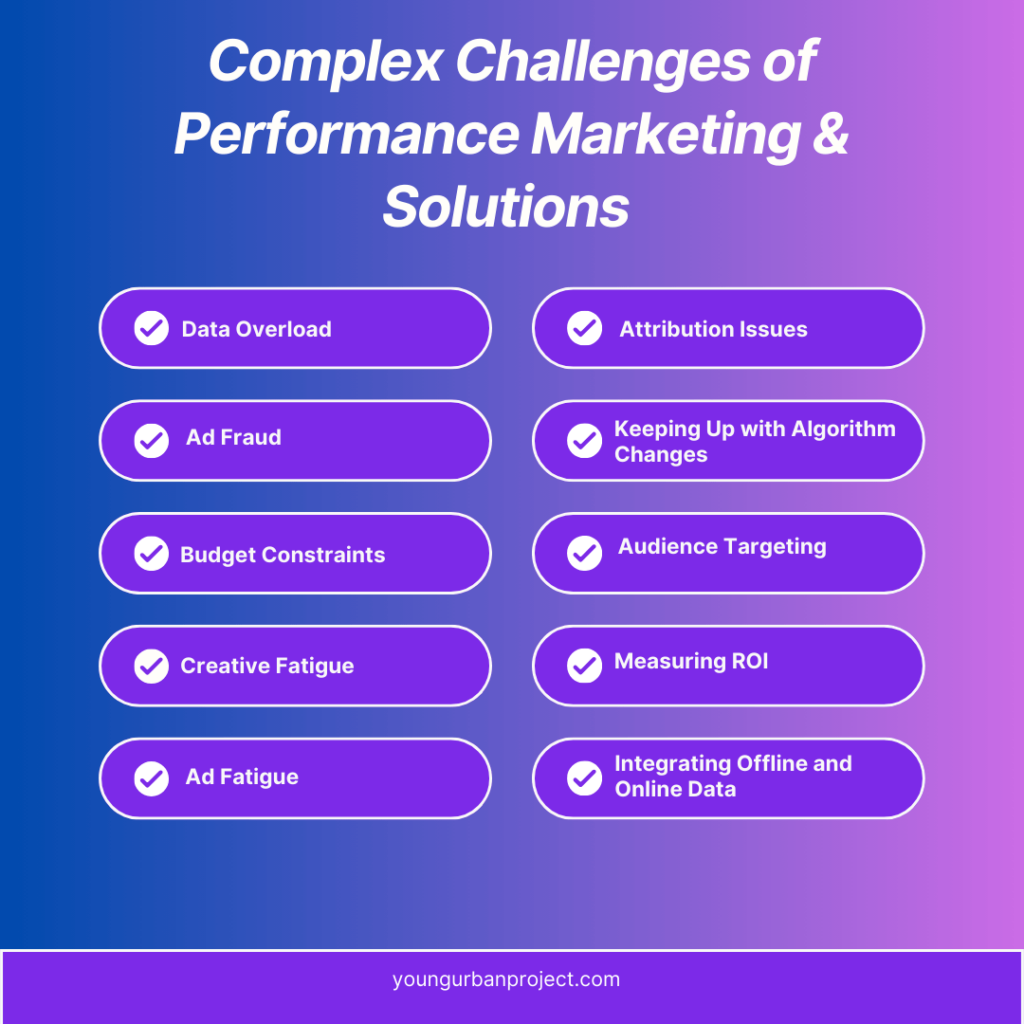Performance marketing has become an important aspect of digital marketing strategies. It focuses on driving measurable actions, ensuring that every marketing dollar spent results in quantifiable outcomes. Despite its effectiveness, performance marketers face several challenges.
In this blog post, we will provide actionable strategies and real-world examples to help marketers navigate the challenges faced by performance marketers. Learn how to effectively handle budget constraints, improve audience targeting, prevent creative fatigue, and accurately Measure ROI. Discover how advanced tools and analytics can streamline data management and attribution, enhancing your ability to make informed decisions.
By staying updated with industry trends, continuously optimizing strategies, and focusing on data-driven decision-making, marketers can turn these performance marketing challenges into opportunities for growth.
Read more: What is Performance Marketing?
What are the biggest Performance Marketing Challenges?

1. Data Overload
Challenge: With the vast amount of daily data generated, performance marketers often struggle to understand it all. The data comes from various sources like social media, websites, and email campaigns, making it difficult to analyze and draw actionable insights.
Solution: To manage data overload, marketers should use advanced analytics tools that aggregate data from multiple sources into a unified dashboard. Tools like Google Analytics, Tableau, and Power BI can help in visualizing data trends and making informed decisions. For instance, an e-commerce company using Google Analytics can track user behavior on their website, identify drop-off points, and optimize their checkout process accordingly.
2. Attribution Issues
Challenge: Determining which marketing channels contribute to conversions is a significant challenge. Multi-channel marketing campaigns make it hard to attribute success to a single source.
Solution: Implementing an advanced attribution model can solve this issue. Marketers should move beyond last-click attribution and consider multi-touch attribution models. These models give credit to all the touchpoints a customer interacts with before converting. For example, an online retailer might find that a customer’s journey involves clicking on a Facebook ad, reading a blog post, and then finally converting through an email offer. By understanding this path, the retailer can optimize each touchpoint.
Also Read: How to Prepare a Performance Marketing Media Plan
3. Ad Fraud
Challenge: Ad fraud, where fraudulent clicks and impressions skew performance data, is a persistent problem. This can lead to wasted ad spend and inaccurate reporting.
Solution: To combat ad fraud, marketers should use tools like ClickCease and Fraudlogix. These tools detect and block fraudulent activity, ensuring that only genuine clicks and impressions are recorded. For instance, a tech company using ClickCease can filter out bots and click farms, ensuring their ads are seen by real potential customers.
4. Keeping Up with Algorithm Changes
Challenge: Search engine and social media algorithms frequently change, impacting the visibility and effectiveness of marketing campaigns.
Solution: Staying updated with the latest algorithm changes is essential. Marketers should follow industry blogs, attend webinars, and participate in forums. Additionally, A/B testing can help understand the impact of these changes and adjust strategies accordingly. For example, after a major update to Facebook’s algorithm, a travel agency might test different types of content to see what resonates best with their audience.
5. Budget Constraints
Challenge: Limited budgets make it challenging to achieve desired marketing outcomes, especially when competing against larger brands with more resources.
Solution: Marketers should focus on high ROI activities and continuously optimize their campaigns for cost efficiency. Using tools like Google Ads and Facebook Ads Manager, they can set precise targeting parameters to reach the most relevant audience. For instance, a small business might allocate a portion of its budget to retargeting ads, which typically have higher conversion rates than standard display ads.
6. Audience Targeting
Challenge: Identifying and reaching the right audience is crucial but challenging. Poor targeting can lead to low engagement and wasted ad spending.
Solution: Creating detailed buyer personas based on demographic, psychographic, and behavioral data can improve targeting. Using tools like Facebook Audience Insights and Google Ads Audience Manager helps in refining audience segments. For example, a fitness brand might use these tools to target ads specifically to health-conscious individuals aged 25-40, living in urban areas, and interested in yoga and healthy eating.
Read more: Types Of Performance Marketing Channels
7. Creative Fatigue
Challenge: Over time, audiences can become tired of seeing the same ads, leading to decreased engagement and effectiveness.
Solution: Regularly refreshing ad creatives and testing new formats can prevent creative fatigue. Marketers should use A/B testing to experiment with different visuals, copy, and call-to-actions. For instance, an online clothing store might rotate its ad creatives every few weeks, featuring new collections or seasonal sales to keep its audience engaged.
8. Measuring ROI
Challenge: Accurately measuring the return on investment (ROI) of performance marketing campaigns and calculating Lifetime Value can be difficult due to various factors influencing customer behavior.
Solution: To maximize ROI, marketers must set clear goals and KPIs from the outset. Leveraging Performance Marketing Tools to Maximize ROI—such as Google Analytics, HubSpot, and Salesforce—helps track conversions, analyze customer journeys, and calculate Lifetime Value effectively. For instance, a SaaS company aiming to acquire 100 new customers can use Google Analytics to monitor leads and conversions, ensuring data-driven decision-making for campaign optimization.
Read more: Top Performance Marketing Metrics
9. Ad Fatigue
Challenge: Constant exposure to the same ads can lead to ad fatigue, where users ignore or become annoyed by repetitive marketing messages.
Solution: To combat ad fatigue, marketers should employ frequency capping, which limits the number of times an ad is shown to the same user. Additionally, rotating ads and creating dynamic content that changes based on user interaction can keep the audience engaged. For example, an online retailer could use dynamic ads that show different products based on the user’s browsing history.
10. Integrating Offline and Online Data
Challenge: Combining offline data (e.g., in-store purchases) with online data (e.g., website visits) to get a holistic view of the customer journey can be complex.
Solution: Utilizing (CRM) systems and data management platforms (DMPs) can help integrate offline and online data. Tools like Salesforce and Adobe Experience Cloud can provide a comprehensive view of customer interactions.
For instance, a brick-and-mortar (like Walmart) store using Salesforce can track in-store purchases and link them with online activities to create a unified customer profile.
Also Read: Difference between Performance Marketing and Paid Advertising
Conclusion
Performance marketing presents unique challenges that require innovative solutions. By leveraging advanced tools and adopting best practices, marketers can overcome these hurdles and drive successful campaigns. Staying updated with industry trends, continuously optimizing strategies, and focusing on data-driven decision-making is key to thriving in the competitive landscape of performance marketing.
Adopting these solutions to performance marketing challenges not only improves marketing efficiency but also ensures that campaigns deliver measurable and impactful results. By addressing these challenges head-on, performance marketers can achieve their goals and contribute significantly to their organizations’ success. For those looking to master the intricacies of performance marketing, the Young Urban Project offers the best performance marketing course. Our program provides in-depth knowledge, practical skills, and insights from industry experts, ensuring you are well-equipped to tackle any marketing challenge and excel in your career.

